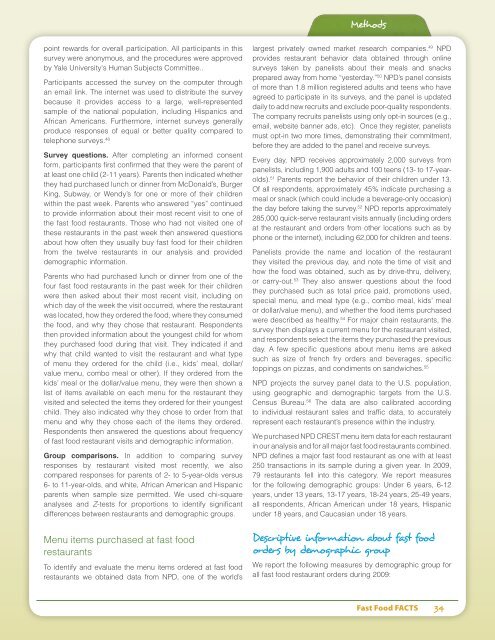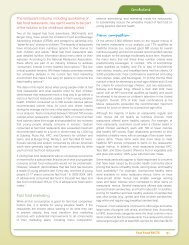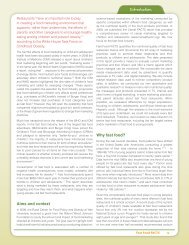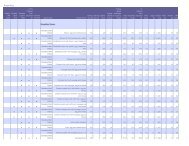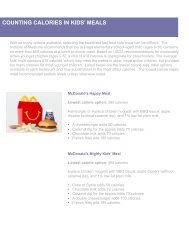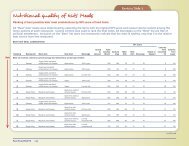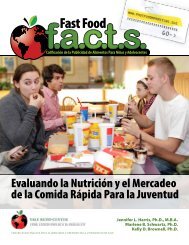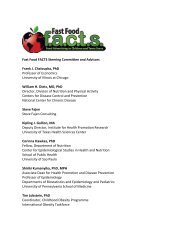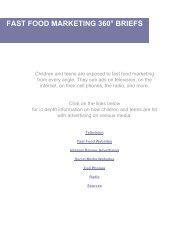Methods Fast food menus and nutritional quality - Fast Food FACTS
Methods Fast food menus and nutritional quality - Fast Food FACTS
Methods Fast food menus and nutritional quality - Fast Food FACTS
Create successful ePaper yourself
Turn your PDF publications into a flip-book with our unique Google optimized e-Paper software.
point rewards for overall participation. All participants in this<br />
survey were anonymous, <strong>and</strong> the procedures were approved<br />
by Yale University's Human Subjects Committee..<br />
Participants accessed the survey on the computer through<br />
an email link. The internet was used to distribute the survey<br />
because it provides access to a large, well-represented<br />
sample of the national population, including Hispanics <strong>and</strong><br />
African Americans. Furthermore, internet surveys generally<br />
produce responses of equal or better <strong>quality</strong> compared to<br />
telephone surveys. 48<br />
Survey questions. After completing an informed consent<br />
form, participants first confirmed that they were the parent of<br />
at least one child (2-11 years). Parents then indicated whether<br />
they had purchased lunch or dinner from McDonald’s, Burger<br />
King, Subway, or Wendy’s for one or more of their children<br />
within the past week. Parents who answered “yes” continued<br />
to provide information about their most recent visit to one of<br />
the fast <strong>food</strong> restaurants. Those who had not visited one of<br />
these restaurants in the past week then answered questions<br />
about how often they usually buy fast <strong>food</strong> for their children<br />
from the twelve restaurants in our analysis <strong>and</strong> provided<br />
demographic information.<br />
Parents who had purchased lunch or dinner from one of the<br />
four fast <strong>food</strong> restaurants in the past week for their children<br />
were then asked about their most recent visit, including on<br />
which day of the week the visit occurred, where the restaurant<br />
was located, how they ordered the <strong>food</strong>, where they consumed<br />
the <strong>food</strong>, <strong>and</strong> why they chose that restaurant. Respondents<br />
then provided information about the youngest child for whom<br />
they purchased <strong>food</strong> during that visit. They indicated if <strong>and</strong><br />
why that child wanted to visit the restaurant <strong>and</strong> what type<br />
of menu they ordered for the child (i.e., kids’ meal, dollar/<br />
value menu, combo meal or other). If they ordered from the<br />
kids’ meal or the dollar/value menu, they were then shown a<br />
list of items available on each menu for the restaurant they<br />
visited <strong>and</strong> selected the items they ordered for their youngest<br />
child. They also indicated why they chose to order from that<br />
menu <strong>and</strong> why they chose each of the items they ordered.<br />
Respondents then answered the questions about frequency<br />
of fast <strong>food</strong> restaurant visits <strong>and</strong> demographic information.<br />
Group comparisons. In addition to comparing survey<br />
responses by restaurant visited most recently, we also<br />
compared responses for parents of 2- to 5-year-olds versus<br />
6- to 11-year-olds, <strong>and</strong> white, African American <strong>and</strong> Hispanic<br />
parents when sample size permitted. We used chi-square<br />
analyses <strong>and</strong> Z-tests for proportions to identify significant<br />
differences between restaurants <strong>and</strong> demographic groups.<br />
Menu items purchased at fast <strong>food</strong><br />
restaurants<br />
To identify <strong>and</strong> evaluate the menu items ordered at fast <strong>food</strong><br />
restaurants we obtained data from NPD, one of the world’s<br />
<strong>Methods</strong><br />
largest privately owned market research companies. 49 NPD<br />
provides restaurant behavior data obtained through online<br />
surveys taken by panelists about their meals <strong>and</strong> snacks<br />
prepared away from home “yesterday.” 50 NPD’s panel consists<br />
of more than 1.8 million registered adults <strong>and</strong> teens who have<br />
agreed to participate in its surveys, <strong>and</strong> the panel is updated<br />
daily to add new recruits <strong>and</strong> exclude poor-<strong>quality</strong> respondents.<br />
The company recruits panelists using only opt-in sources (e.g.,<br />
email, website banner ads, etc). Once they register, panelists<br />
must opt-in two more times, demonstrating their commitment,<br />
before they are added to the panel <strong>and</strong> receive surveys.<br />
Every day, NPD receives approximately 2,000 surveys from<br />
panelists, including 1,900 adults <strong>and</strong> 100 teens (13- to 17-yearolds).<br />
51 Parents report the behavior of their children under 13.<br />
Of all respondents, approximately 45% indicate purchasing a<br />
meal or snack (which could include a beverage-only occasion)<br />
the day before taking the survey. 52 NPD reports approximately<br />
285,000 quick-serve restaurant visits annually (including orders<br />
at the restaurant <strong>and</strong> orders from other locations such as by<br />
phone or the internet), including 62,000 for children <strong>and</strong> teens.<br />
Panelists provide the name <strong>and</strong> location of the restaurant<br />
they visited the previous day, <strong>and</strong> note the time of visit <strong>and</strong><br />
how the <strong>food</strong> was obtained, such as by drive-thru, delivery,<br />
or carry-out. 53 They also answer questions about the <strong>food</strong><br />
they purchased such as total price paid, promotions used,<br />
special menu, <strong>and</strong> meal type (e.g., combo meal, kids’ meal<br />
or dollar/value menu), <strong>and</strong> whether the <strong>food</strong> items purchased<br />
were described as healthy. 54 For major chain restaurants, the<br />
survey then displays a current menu for the restaurant visited,<br />
<strong>and</strong> respondents select the items they purchased the previous<br />
day. A few specific questions about menu items are asked<br />
such as size of french fry orders <strong>and</strong> beverages, specific<br />
toppings on pizzas, <strong>and</strong> condiments on s<strong>and</strong>wiches. 55<br />
NPD projects the survey panel data to the U.S. population,<br />
using geographic <strong>and</strong> demographic targets from the U.S.<br />
Census Bureau. 56 The data are also calibrated according<br />
to individual restaurant sales <strong>and</strong> traffic data, to accurately<br />
represent each restaurant’s presence within the industry.<br />
We purchased NPD CREST menu item data for each restaurant<br />
in our analysis <strong>and</strong> for all major fast <strong>food</strong> restaurants combined.<br />
NPD defines a major fast <strong>food</strong> restaurant as one with at least<br />
250 transactions in its sample during a given year. In 2009,<br />
79 restaurants fell into this category. We report measures<br />
for the following demographic groups: Under 6 years, 6-12<br />
years, under 13 years, 13-17 years, 18-24 years, 25-49 years,<br />
all respondents, African American under 18 years, Hispanic<br />
under 18 years, <strong>and</strong> Caucasian under 18 years.<br />
Descriptive information about fast <strong>food</strong><br />
orders by demographic group<br />
We report the following measures by demographic group for<br />
all fast <strong>food</strong> restaurant orders during 2009:<br />
<strong>Fast</strong> <strong>Food</strong> <strong>FACTS</strong> 34


